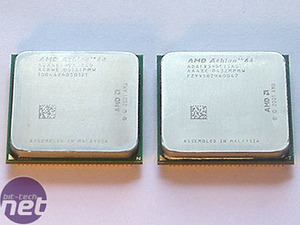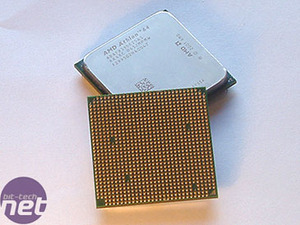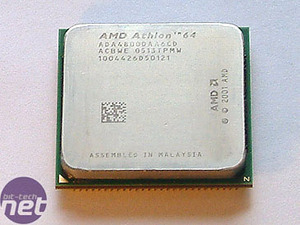There have been rumours going around about the impressive feat of the Athlon 64 X2 series of processors being backwards compatible with current Athlon 64's. After the months of speculation, we can say that this is the case.
The processors are the same without delving under the integrated heatspreader, and the model number scheme will remain the same - the larger the number the higher performance attainable from the processor. The first dual core Athlon 64 X2's, which were code named Toledo on all of AMD's roadmaps, will come at clock speeds of 2.4GHz and 2.2GHz with two different iterations of L2 cache. The 4800+ and 4400+ will come with 1MB of L2 cache per core, while the 4600+ and 4200+ will be equipped with 512KB of L2 cache per core. Incidentally, while on the subject of cache, each core has its own 64K of L1 instruction and 64K of L1 data cache, which means a total of 256KB L1 cache for each processor.

 The processors will not come cheap, ranging from $537 for the 4200+ to $1001 for the 4800+. As we said, they're expensive. You will need to understand that dual core processors are not for everyone at this moment in time, and determine whether or not you would really benefit from the extra core. AMD are not replacing its current flagship gaming processor, the FX-55, which is priced at a modest US$827 on AMD's pricing page.
The processors will not come cheap, ranging from $537 for the 4200+ to $1001 for the 4800+. As we said, they're expensive. You will need to understand that dual core processors are not for everyone at this moment in time, and determine whether or not you would really benefit from the extra core. AMD are not replacing its current flagship gaming processor, the FX-55, which is priced at a modest US$827 on AMD's pricing page.
There are a number of things to consider if you are thinking about making the leap to a dual core system, as not everyone will benefit from the extra core. Thus, the Athlon 64 FX-55 is still a valid consideration if you are an avid gamer - AMD still believes that the Athlon 64 FX-55 is its top gaming processor. There is also the issue of compatibility to take under the wing when considering the AMD vs. Intel dual core debacle. Unlike Intel's Pentium D, AMD's dual core processors pin compatible with existing socket 939 motherboards, and are capable of acting as a simple replacement after updating the BIOS to one that has support for a dual core processor.
 Despite the Athlon 64 X2 4800+ having two cores on the same die, it's die size is only slightly larger than an FX-55 die. The size differential is down to the fact that the Athlon 64 X2 4800+ is manufactured on the smaller 90nm SOI process, as opposed to the 130nm SOI process used on the FX-55. This reduction in relative size means that the power consumption of the Athlon 64 X2 4800+ is roughly the same as the Athlon 64 FX-55, which is a pretty impressive feat.
Despite the Athlon 64 X2 4800+ having two cores on the same die, it's die size is only slightly larger than an FX-55 die. The size differential is down to the fact that the Athlon 64 X2 4800+ is manufactured on the smaller 90nm SOI process, as opposed to the 130nm SOI process used on the FX-55. This reduction in relative size means that the power consumption of the Athlon 64 X2 4800+ is roughly the same as the Athlon 64 FX-55, which is a pretty impressive feat.
It's also worth noting that the dual core Athlon 64 X2's will have support for all of the Athlon 64's current features, including advanced virus protection and Cool 'n' Quiet technology. Cool 'n' Quiet will work on a whole chip basis, rather than each individual core, so if you load one core, both cores will increase their clock speed to reflect the additional load placed on the CPU.
The processors are the same without delving under the integrated heatspreader, and the model number scheme will remain the same - the larger the number the higher performance attainable from the processor. The first dual core Athlon 64 X2's, which were code named Toledo on all of AMD's roadmaps, will come at clock speeds of 2.4GHz and 2.2GHz with two different iterations of L2 cache. The 4800+ and 4400+ will come with 1MB of L2 cache per core, while the 4600+ and 4200+ will be equipped with 512KB of L2 cache per core. Incidentally, while on the subject of cache, each core has its own 64K of L1 instruction and 64K of L1 data cache, which means a total of 256KB L1 cache for each processor.


There are a number of things to consider if you are thinking about making the leap to a dual core system, as not everyone will benefit from the extra core. Thus, the Athlon 64 FX-55 is still a valid consideration if you are an avid gamer - AMD still believes that the Athlon 64 FX-55 is its top gaming processor. There is also the issue of compatibility to take under the wing when considering the AMD vs. Intel dual core debacle. Unlike Intel's Pentium D, AMD's dual core processors pin compatible with existing socket 939 motherboards, and are capable of acting as a simple replacement after updating the BIOS to one that has support for a dual core processor.

It's also worth noting that the dual core Athlon 64 X2's will have support for all of the Athlon 64's current features, including advanced virus protection and Cool 'n' Quiet technology. Cool 'n' Quiet will work on a whole chip basis, rather than each individual core, so if you load one core, both cores will increase their clock speed to reflect the additional load placed on the CPU.

MSI MPG Velox 100R Chassis Review
October 14 2021 | 15:04






Want to comment? Please log in.